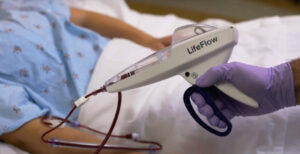
Although it is well understood that rapid volume resuscitation is urgent in cases of hemorrhagic and circulatory shock to help correct hemodynamic imbalances, practitioners often encounter barriers to successful implementation. These barriers include infusion methods that are complex to utilize, and methods that are too slow for the intended purpose.1
In the following case, an all-too-common emergency scenario takes place, where an initial course of care becomes complicated by the development of secondary problems. Care providers must identify and implement effective inpatient resources when faced with the challenge of managing rapid hemodynamic shifts.
Case presentation
This patient is a 75-year-old male who presents to the emergency department (ED) with a chief complaint of right retro-orbital pressure and headache for the past 4 days. His medical history includes hypertension, diabetes, hyperlipidemia, carotid endarterectomy, and smoking.
Upon arrival to the ED, his pulse is 152, respiratory rate is 16, BP 116/79, O2 sat 95%, and temperature 97°F. His skin is warm, dry, and pink, with normal peripheral perfusion, and he is alert and oriented x 4. His initial disposition was to the progressive care unit due to findings of atrial fibrillation with RVR and an elevated troponin of 11.
Challenges
The patient was negative for STEMI. A transthoracic echocardiogram (TTE) was concerning for a right apical thrombus, so he was started on a heparin drip. Unfortunately, six days later his course was complicated by coffee ground emesis, and the heparin drip was discontinued pending a planned EGD.
The patient was subsequently noted to have bloody stools and was taken to the GI lab where a gastroduodenal artery embolization was performed. Four days later he experienced a recurrence of bloody stools, and a duodenal clip was placed during a follow-up EGD.
Late the following day, the patient’s hemoglobin (Hgb) was found to be 9.1. Transfusions were ordered, with a recommendation to return the patient to interventional radiology for further evaluation of the source of the bleed.
Overnight the patient had active GI bleeding; at 0310 his Hgb was 6.9. He became acutely hypotensive and received multiple transfusions via IV pump and pressure bags in an attempt to correct his hemorrhagic shock; a repeat Hgb at 0755 was 6.7. His vital signs at this time were a BP of 78/40, HR 101, and RR 26.
Management
At 0813 a LifeFlow device was sent to the unit from the ED and a mass transfusion protocol was initiated. Four units of packed red blood cells (PRBCs) were infused in the first 12 minutes of LifeFlow use. The patient’s blood pressure immediately began to stabilize. The LifeFlow device was then used to infuse two additional units of PRBCs slowly while awaiting OR intervention. Additionally, a levophed drip was initiated at 20 mcg/min.
Outcome and discussion
The patient’s vital signs immediately following the first four units of PRBCs infused with LifeFlow were: BP 135/67, HR 122, and RR 15. The levophed drip was weaned to 10 mcg/min within an hour of the LifeFlow’s introduction. Three hours after LifeFlow was initiated, the patient’s hemoglobin level had risen to 12.3.
Approximately four hours after the LifeFlow was used for rapid infusion, the patient was taken to the OR for an emergency laparotomy to control his duodenal hemorrhage. Following surgery, he was able to be removed from vasopressors. He was returned to the progressive care unit the following week.
This case illustrates how successfully managing hemodynamic shifts by using pressure bags and IV pumps can be ineffective. For example, the flow rate of pressure bags is hampered by maintaining bag pressure and changing bags.2
Furthermore, expensive and complex mechanical infusers are not typically readily available throughout the hospital. They can also require extensive staff training for competency.1
In contrast, the nursing staff reported that the LifeFlow instructions were easy to understand, setup was quick, and the device was simple to use. It was easily and quickly portable from the ED to the inpatient unit thanks to its small size. Although staff had no previous experience with it, they were able to operate it by relying solely on the pamphlet in the package.
Additional nursing staff who observed the LifeFlow in use were so impressed with the ease of use and speed of the infusions that they asked to participate in the infusion process. In a critical situation, the clinical team was able to use LifeFlow to stabilize this patient quickly by administering four units of PRBCs in approximately 12 minutes. As one nurse related: “We strongly feel that without this device the patient would have died.”
1. Piehl, M., Park, C.W. When Minutes Matter: Rapid Infusion in Emergency Care. Curr Emerg Hosp Med Rep 9, 116–125 (2021). https://doi.org/10.1007/s40138-021-00237-6. https://link.springer.com/article/10.1007/s40138-021-00237-6
2. Iserson, Kenneth & Criss, Elizabeth. (1986). Combined effect of catheter and tubing size on fluid flow. The American journal of emergency medicine. 4. 238-40. 10.1016/0735-6757(86)90077-X. https://www.researchgate.net/profile/Kenneth-Iserson/publication/19198309_Combined_effect_of_catheter_and_tubing_size_on_fluid_flow/links/5c59a53045851582c3cff4ca/Combined-effect-of-catheter-and-tubing-size-on-fluid-flow.pdf

